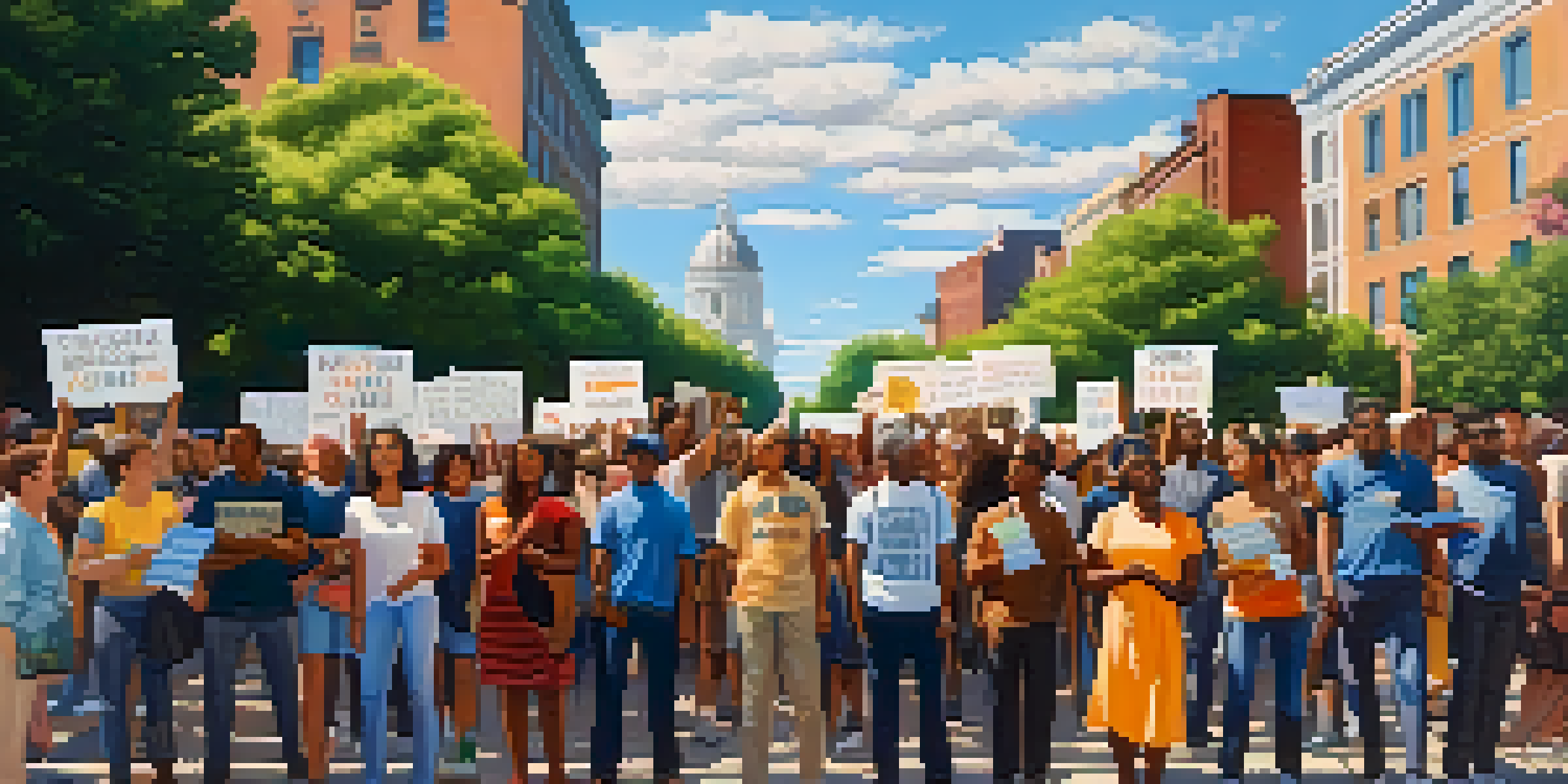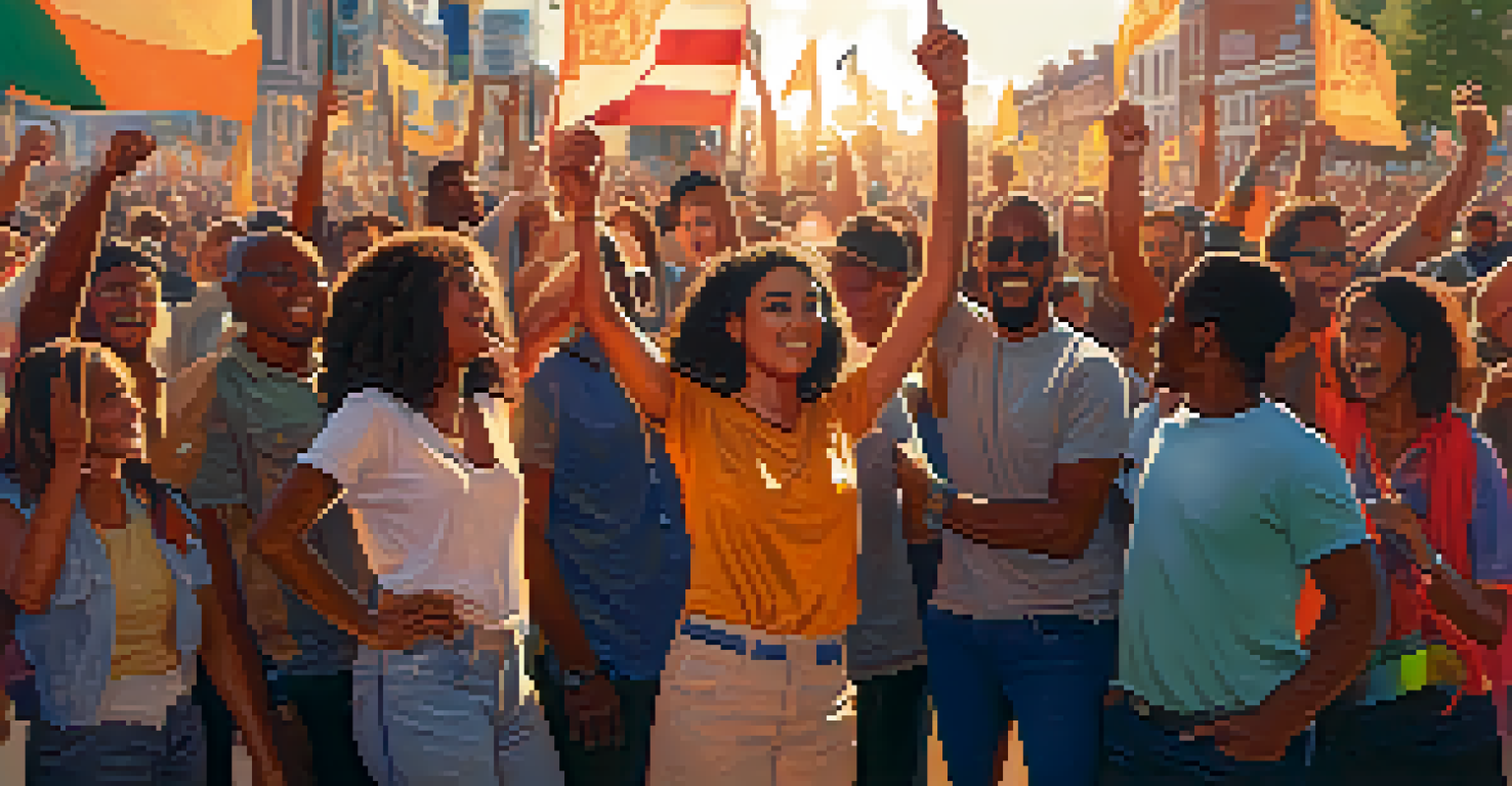Essential Self Defense Techniques for Activists at Protests

Understanding Your Environment: Situational Awareness
Before engaging in any protest, it’s crucial to develop situational awareness. This means being mindful of your surroundings, identifying potential risks, and recognizing escape routes. By observing the behavior of the crowd and law enforcement, you can anticipate shifts in the atmosphere that may signal danger.
In any situation, awareness is your best defense.
For instance, if you notice a sudden change in police presence or aggressive behavior from certain individuals, it’s wise to reassess your position. Keeping your head up and your senses sharp helps you stay one step ahead. Remember, awareness is your first line of defense against potential threats.
In practice, try to scan the environment every few minutes. Look for exits, potential hazards, and the general mood of the crowd. This habit not only enhances your safety but also empowers you to make informed decisions throughout the protest.
Basic Physical Techniques for Self Defense
Knowing a few basic self-defense techniques can be invaluable in a tense situation. Moves like the palm strike, knee strike, and elbow strike are simple yet effective. They allow you to create distance from an aggressor or escape a hold without extensive training.

For example, if someone grabs your wrist, a quick twist and a strong palm strike to their nose can give you the moment you need to break free. These techniques focus on targeting sensitive areas of the body, maximizing your effectiveness even if you're smaller or less physically strong.
Stay Aware for Your Safety
Developing situational awareness helps you identify risks and respond appropriately during protests.
While mastering these moves takes practice, it's essential to familiarize yourself with their mechanics. Consider participating in a self-defense workshop or watching instructional videos to gain confidence in your abilities.
De-escalation Techniques: Avoiding Conflict
In many situations, the best defense is to avoid confrontation altogether. De-escalation techniques can help you diffuse tension before it escalates into violence. Simple strategies include maintaining a calm demeanor, using non-threatening body language, and actively listening to the other party.
The best way to predict the future is to create it.
For instance, if someone confronts you aggressively, try to speak softly and acknowledge their feelings. Phrases like, 'I understand why you’re upset,' can often lower the temperature of the interaction. Your goal is to create a dialogue instead of a conflict.
Remember, de-escalation isn’t about backing down; it’s about defusing a situation to ensure everyone’s safety. Practicing these skills can help you become more adept at managing potentially volatile encounters at protests.
Using Everyday Objects for Self Defense
You might be surprised to learn that many everyday items can serve as effective self-defense tools. Keys, pens, and even your phone can be used to defend yourself if necessary. For instance, holding your keys between your fingers can create a makeshift weapon to ward off an aggressor.
Similarly, a pen can be used to jab sensitive areas like the neck or eyes. These improvised tools allow you to defend yourself without needing extensive training or special equipment. The key is to maintain a mindset of resourcefulness, recognizing the potential of what you have on hand.
Learn Basic Self-Defense Moves
Mastering simple self-defense techniques can empower you to protect yourself in tense situations.
However, it’s equally important to use these objects judiciously. Your goal should always be to escape a dangerous situation, not to escalate it further. Being aware of your surroundings and knowing how to utilize what you have can make all the difference.
The Importance of Teamwork and Buddy Systems
Having a buddy system during protests can significantly enhance safety. Staying close to friends or fellow activists allows you to watch each other's backs and respond quickly in case of trouble. This sense of community can also serve as a deterrent to potential aggressors, who may be less likely to target a group.
When you’re part of a team, communication is key. Establish signals for when someone feels uncomfortable or is in distress. Whether it’s a hand signal or a code word, having a system in place ensures everyone knows how to react swiftly and effectively.
Moreover, working together can provide emotional support, reducing anxiety in high-pressure situations. Always remember, there’s strength in numbers, and being part of a collective can empower you as an activist.
Recognizing and Responding to Aggression
At protests, you may encounter aggressive behavior from both counter-protesters and law enforcement. Recognizing the signs of aggression early can help you decide how to respond or escape. Look for body language cues, such as clenched fists, tense posture, or raised voices.
If you sense that a situation is escalating, it’s crucial to react quickly. If possible, create distance between yourself and the aggressor, and try to move towards a safer area. Staying composed can also help you think clearly and make better decisions in the heat of the moment.
Prioritize Teamwork and Communication
Using a buddy system enhances safety and provides emotional support during protests.
Ultimately, your safety is the priority. If you feel threatened, don’t hesitate to leave the area or seek help from others nearby. Understanding the dynamics of aggression can empower you to navigate these challenging situations more effectively.
After the Protest: Debriefing and Self-Care
After a protest, it’s essential to take time to debrief and process your experience. Reflecting on what happened can help you understand your reactions and learn from the situation. Consider talking with friends or fellow activists to share insights and feelings about the day’s events.
Self-care is equally important after an intense experience. Engage in activities that help you unwind, whether it’s journaling, meditating, or simply spending time in nature. Taking care of your mental health ensures you’re prepared for future activism and protests.

Lastly, remember that it’s okay to seek professional help if needed. Activism can be emotionally taxing, and there’s no shame in reaching out for support. Prioritizing your well-being is crucial to sustaining your passion for social change.